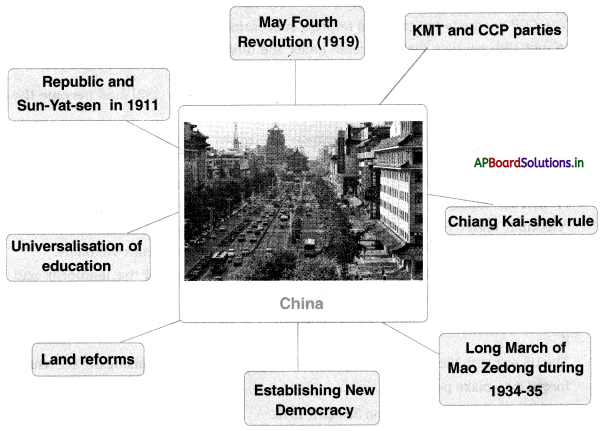Students can go through AP State Board 10th Class Social Studies Notes Chapter 15 National Liberation Movements in the Colonies to understand and remember the concept easily.
AP State Board Syllabus 10th Class Social Studies Notes Chapter 15 National Liberation Movements in the Colonies
→ In this chapter, we will read about the plight of the colonies and how they began to fight against the colonial domination of the European powers.
→ Western colonial powers had carved out their spheres of influence in different parts of China.
→ In 1911 a republic was established in China under Sun-Yat-Sen, who is regarded as the founder of modern China.
→ He prepared a program of ‘nationalism – democracy – socialism’ to develop China.
→ But Sun could not consolidate itself.
→ On 4th May 1919, a demonstration was held in Beijing to protest against the decisions of the Versailles peace conference.
→ After this Guomindang and the Chinese Communist Party tried to bring stability to China.
→ Guomindang identified ‘four great needs’ as clothing, food, housing, and transportation.
→ After the death of Sun, Chiang Kai-shek emerged as the leader who stood for unified behavior.
→ Chiang was a conservative and he encouraged women to develop virtues of chastity, appearance, speech, and work.
→ Mao Zedong emerged as a major CCP leader by basing his revolutionary program on the peasantry.
→ He conducted ‘Long March’ of over 6,000 miles.
→ He ended warlordism and carried out land reforms and fought foreign imperialism.
→ The Peoples Republic of China government was established in 1949 on the principles of the ‘New Democracy’.
![]()
→ The CCP conducted hectic land reforms successfully.
→ In mid 19th century, Vietnam came under the direct rule of the French who made the emperor here a puppet.
→ Vietnam exported two-thirds of its rice production and by 1931 had become the third-largest exporter of rice in the world.
→ French colonizers tried to give education through which they believed Vietnamese civilize.
→ Educated youth organized themselves and fought to drive away foreign forces like French and Japanese.
→ ‘Vietminh’ under ‘Ho Chi Minh fought against the French for 8 years and defeated them
→ In the peace agreement, Vietnam was divided into North and South Vietnam.
→ North Vietnam headed by Ho Chi Minh, confiscated the land of the landlords and distributed it among the landless.
→ The US worried about communists gaining power in Vietnam and their attempt to verify it.
→ The US war with Vietnam was long-drawn and got criticism even inside the US, which forced it to make peace.
→ Finally, Vietnam was unified on 30 April 1975.
→ In Western Africa, Nigeria was the colony of the British.
→ It encouraged conflict and competition between the three major tribal groups and was able to ‘divide and rule’.
→ Herbert Macaulay founded the first Nigerian political party won consecutive elections.
→ The Nigerian Youth Movement was founded by Nnamdi Azikiwe.
→ Macaulay and Azikiwe together worked for the independence of Nigeria in 1963.
→ Unfortunately, Nigeria slipped into Civil war and was under military dictatorship till 1999.
→ Nigerians elected a democratic government in 1999.
→ Oil was discovered in the 1950s in the Niger Delta and many MNCs extracted oil and shared profits with military leaders.
→ Oil spillage from wells has a major impact on the ecosystem.
![]()
→ In 1990 an eminent human rights activist and environmentalist Ken Saro Wiwa was executed.
→ Nigeria is still making efforts to weld together as a nation, work out a stable democratic system and gain control over its material resources.
→ Land reforms: Making attempts to see that the land is not concentrated but distributed more equitably
→ Landlordism: Large landlords took over the lands of small peasants and made them work as tenant farmers
→ New Democracy: An alliance of all social classes opposed to land4ordlsm and Imperialism
→ Forced labor: DurIng colonial period the peasants were forced to do forced labor on the personal land of the landlords
→ Chemical arms: Weapons that use poisonous gases and chemicals to kill and injure people
→ Weak: A democracy where the practice of democratic principles was not made possible
→ Pan-Africanism: Idea which promotes the unity of all African peoples irrespective of country or tribe
→ Warlords: The leaders of military groups that fight against other groups within a. country regional military power
→ May Fourth Movement: On 14th May 1919 an angry demonstration was held in Beijing to protest against the decisions of the Versailles peace conference
→ Foot-binding: A cruel practice of not allowing women to have fully grown feet
→ Four great needs: Clothing, food, housing, and transport
→ Long March: In 1934 Mao Zedong conducted this Historic t1g March with his Red Army a distance of 10,000 km one year
→ Military Garrisons: Groups of soldiers living in a town or fort to defend It
![]()
→ Colons: French citizens living In Vietnam
→ Civilising Mission: The French colonizers thought education to Vietnamese was one way to civilize them
→ Napalm bombs: ‘A deadly bomb which caused intense damage to humans
→ Agent Orange: A defoliant plant killer which destroyed plants arid tres and made the land barren for a long time
→ Bonded labor: À person who Is legally owned by another person and is forced to work for him without paying anything


